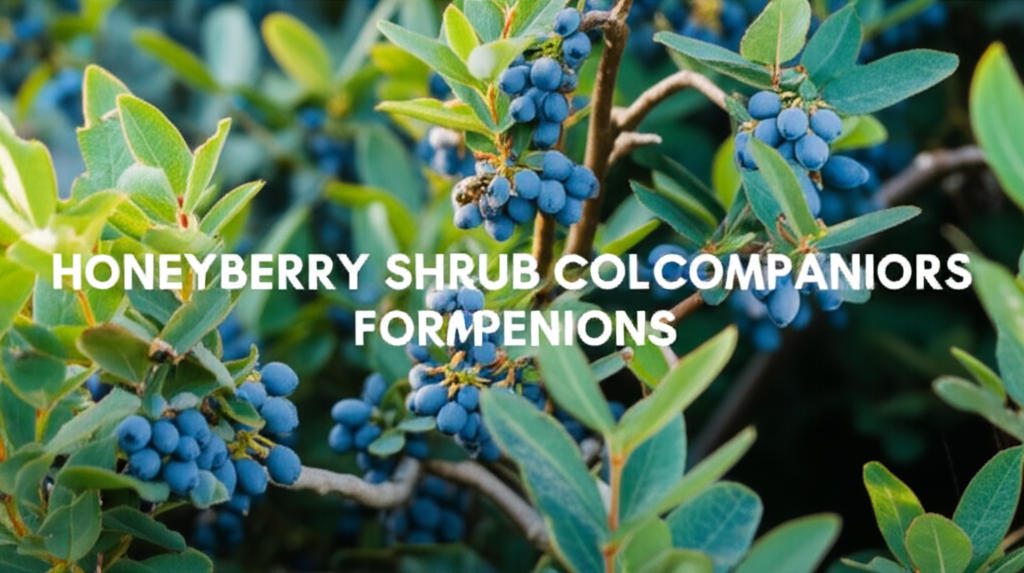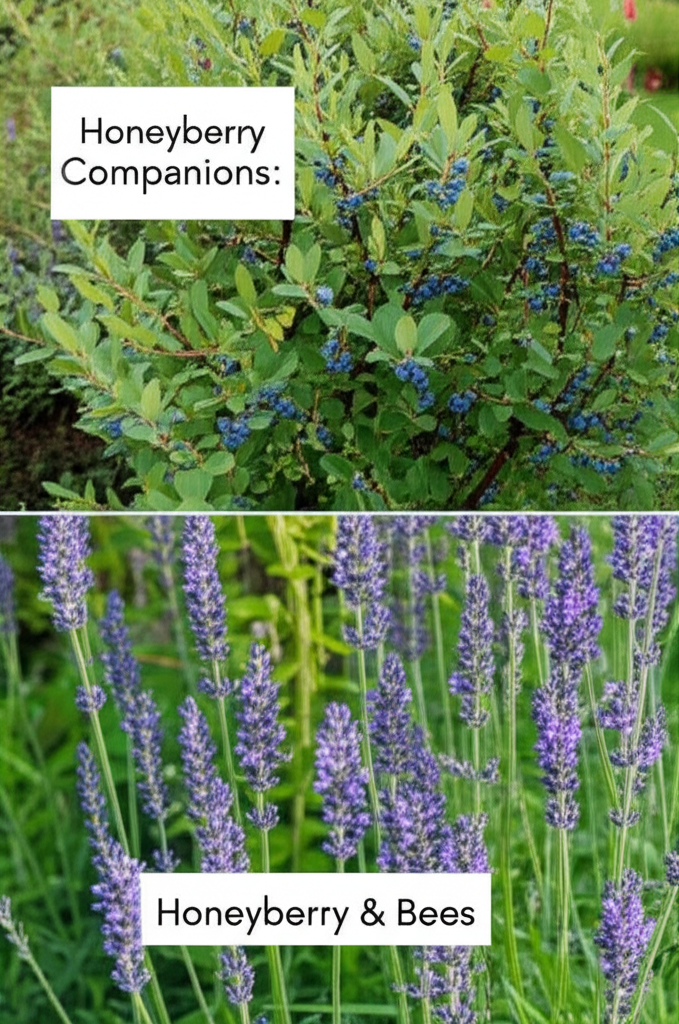The Sweet Symphony: Why Honeyberries Need Bee Buddies
Honeyberries, also known as haskap or Lonicera caerulea, are becoming increasingly popular for their early-blooming nature and delicious, antioxidant-rich berries. But for a bountiful harvest, these shrubs rely on cross-pollination, and that means bees. While honeyberries are attractive to pollinators, enhancing their environment with other bee-friendly shrubs can create a powerful ecological synergy. This article explores the best companion shrubs that will not only support your honeyberry plants but also transform your garden into a buzzing haven for bees.
Understanding Honeyberry Pollination Needs
Honeyberries are dioecious, meaning they require at least two different varieties (cultivars) planted in close proximity for successful fruit set. Even with multiple varieties, attracting a diverse and robust population of pollinators is crucial. Bees, from honeybees to native bumblebees and solitary bees, are the primary drivers of this pollination. A well-planned companion planting strategy ensures a continuous supply of nectar and pollen throughout the blooming season, supporting bee populations when they need it most.
Why Companion Planting for Bees Matters
Companion planting for bees is more than just about increasing honeyberry yields; it’s about fostering a healthy, resilient ecosystem in your garden. By offering a variety of floral resources, you:
- Attract a wider range of bee species, increasing biodiversity.
- Provide a consistent food source, supporting bee health and longevity.
- Reduce competition for pollinators by offering staggered bloom times.
- Enhance the overall productivity of your garden through increased pollination.
- Create a more aesthetically pleasing and vibrant landscape.
Top Companion Shrubs for Honeyberries and Bees

When selecting companion shrubs for your honeyberry patch, consider their bloom time, nectar and pollen quality, and overall attractiveness to bees. Ideally, you want plants that bloom before, during, and after your honeyberries, ensuring a continuous food supply.
Early Season Bloomers (Pre-Honeyberry)
Starting the season with a flourish of bee-friendly flowers is vital for waking up and nourishing early-emerging bees.
Red Twig Dogwood (Cornus sericea)
While not primarily grown for its flowers, the small white flowers of Red Twig Dogwood offer an early nectar source for emerging bees. Its true value lies in its vibrant red stems, which provide winter interest and habitat.
Serviceberry (Amelanchier spp.)
Serviceberry, also known as Juneberry or Shadbush, is an exceptional early-blooming shrub. Its delicate white flowers appear in early spring, often before the honeyberries, providing a crucial early nectar and pollen boost. Many native bee species are particularly drawn to Serviceberry.
Pussy Willow (Salix discolor)
The fuzzy catkins of Pussy Willow are a magnet for bees in early spring. They are a vital source of both pollen and nectar when few other plants are in bloom, making them indispensable for supporting early bee activity.
Mid-Season Bloomers (Coinciding with Honeyberries)
These shrubs will bloom alongside your honeyberries, ensuring peak pollination for both.
Butterfly Bush (Buddleja spp.)
Despite its name, Butterfly Bush is also highly attractive to bees. Its long, cone-shaped blooms are packed with nectar and provide a continuous food source throughout the summer. Be mindful of introducing sterile or non-invasive varieties in your region.
Elderberry (Sambucus spp.)
Elderberry bushes produce large, flat clusters of fragrant white flowers that are a bee favorite. These blooms offer abundant nectar and pollen, and the subsequent berries are also a food source for birds, adding to your garden’s biodiversity.
Fothergilla (Fothergilla spp.)
Fothergilla is a fantastic native shrub known for its fragrant, bottlebrush-like white flowers in spring and stunning fall foliage. Its blooms are highly attractive to bees, providing a rich source of nectar and pollen during the honeyberry blooming period.
Late Season Bloomers (Post-Honeyberry)
Extending the blooming season supports bees as they prepare for winter.
Blueberry (Vaccinium spp.)
While often grown for its berries, the bell-shaped flowers of blueberries are also a good source of nectar for bees. Planting blueberries nearby can offer a secondary bloom period after honeyberries have finished.
Hydrangea (Hydrangea spp.)
Certain varieties of Hydrangea, particularly those with open, flat-topped flower heads like Panicle Hydrangeas (Hydrangea paniculata), offer accessible nectar and pollen for bees. Avoid mophead varieties with sterile florets.
Ninebark (Physocarpus opulifolius)
Ninebark produces clusters of small, white or pinkish flowers that are attractive to a wide range of pollinators, including bees. It’s a hardy native shrub offering multiple benefits.
Key Facts and Comparison Table
Here’s a quick look at some of the top companion shrubs and their benefits for bees and honeyberries:
| Shrub | Scientific Name | Primary Bloom Time | Bee Attraction | Honeyberry Benefit | Other Benefits |
|---|---|---|---|---|---|
| Serviceberry | Amelanchier spp. | Early Spring | High (Pollen & Nectar) | Early pollination support | Edible berries, fall color, native |
| Pussy Willow | Salix discolor | Very Early Spring | Very High (Pollen & Nectar) | Supports emerging bees | Winter interest |
| Elderberry | Sambucus spp. | Late Spring/Early Summer | High (Nectar & Pollen) | Mid-season pollination | Edible berries, attracts birds |
| Fothergilla | Fothergilla spp. | Spring | High (Nectar & Pollen) | Co-blooms with honeyberries | Fragrant flowers, fall color, native |
| Butterfly Bush | Buddleja spp. | Summer | Very High (Nectar) | Sustains pollinators | Attracts butterflies, long bloom time |
| Hydrangea (Panicle) | Hydrangea paniculata | Summer | Medium (Nectar & Pollen) | Late-season food source | Ornamental value |
Designing Your Bee-Friendly Garden: Steps and Considerations
Creating a successful companion planting scheme involves more than just picking out pretty flowers. It requires thoughtful planning to ensure a thriving ecosystem.
Steps to Establish Your Companion Planting Scheme
- Assess Your Site: Consider sunlight, soil type, and drainage in your honeyberry planting area. Choose companion shrubs that will thrive in similar conditions.
- Identify Bloom Times: Research the specific bloom times of your chosen companion shrubs and your honeyberry cultivars. Aim for staggered bloom periods to provide continuous food.
- Consider Pollinator Needs: Think about the types of bees you want to attract. Some plants are better for specific bee species (e.g., fuzzy flowers for bumblebees).
- Plant Strategically: Place companion shrubs within close proximity to your honeyberries, ideally within a few feet, to maximize pollination efficiency.
- Provide Water Sources: Bees need water. Consider a shallow dish filled with pebbles or a small water feature nearby.
- Avoid Pesticides: Absolutely essential for bee health. Opt for organic pest control methods.
- Include Native Plants: Native shrubs often provide the best food sources for local bee populations and require less maintenance.
Pros and Cons of Companion Planting for Bees
While the benefits are substantial, it’s helpful to weigh the advantages and disadvantages.
| Pros | Cons |
|---|---|
| Increased honeyberry yield through better pollination. | Requires careful planning and selection of appropriate species. |
| Supports diverse and healthy bee populations. | Some plants may require specific soil or light conditions. |
| Extended blooming season provides continuous food for pollinators. | Potential for some non-native plants to become invasive if not chosen carefully. |
| Enhanced garden biodiversity and aesthetic appeal. | Initial investment in multiple plants. |
| Reduced reliance on chemical pest control. | Competition for resources (water, nutrients) if plants are too densely packed. |
Beyond Shrubs: Other Bee-Attracting Garden Elements
While companion shrubs are excellent, a truly bee-friendly garden incorporates a variety of elements to support these vital pollinators year-round.
Perennials and Annuals
Don’t forget to intersperse your shrub borders with a mix of bee-friendly perennials and annuals. Lavender, Bee Balm (Monarda), Coneflower (Echinacea), and Borage are excellent choices that provide continuous nectar and pollen throughout the summer.
Herbs
Many common culinary herbs are also bee magnets. Mint, Thyme, Rosemary, and Oregano, when allowed to flower, offer valuable nectar and pollen.
Providing Habitat
Bees don’t just need food; they need safe places to nest and overwinter. Consider leaving some areas of your garden a little ‘wild’ with leaf litter or dead wood for solitary bees. Bee houses or hotels can also provide crucial nesting sites.
Conclusion: Cultivating a Thriving Ecosystem
By thoughtfully selecting and planting companion shrubs around your honeyberry bushes, you create a more robust and productive environment for both your plants and the essential pollinators that make it all happen. A garden rich in diverse floral resources is a testament to a gardener’s commitment to supporting nature. Embrace the beauty of a buzzing, thriving ecosystem, and enjoy the sweet rewards of your pollinator-friendly efforts – including a bumper crop of delicious honeyberries!


